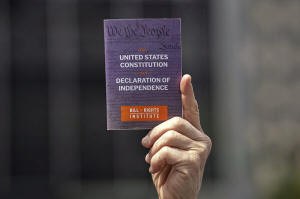Kidnappers in France target cryptocurrency entrepreneurs for ransom
[May 05, 2025]
By BILL BARROW
ATLANTA (AP) — It's what one historian calls an “elaborate, clunky
machine,” one that's been fundamental to American democracy for more
than two centuries.
The principle of “checks and balances” is rooted in the Constitution's
design of a national government with three distinct, coequal branches.
President Donald Trump in his first 100 days tested that system like
rarely before, signing dozens of executive orders, closing or sharply
reducing government agencies funded by Congress, and denigrating judges
who have issued dozens of rulings against him.
“The framers were acutely aware of competing interests, and they had
great distrust of concentrated authority,” said Dartmouth College
professor John Carey, an expert on American democracy. “That’s where the
idea came from.”
Their road map has mostly prevented control from falling into “one
person’s hands,” Carey said. But he warned that the system depends on
“people operating in good faith ... and not necessarily exercising power
to the fullest extent imaginable.”
Here's a look at checks and balances and previous tests across U.S.
history.
A fight over Jefferson ignoring Adams' appointments
The foundational checks-and-balances fight: President John Adams’ made
last-minute appointments before he left office in 1801. His successor,
Thomas Jefferson, and Secretary of State James Madison ignored them.
William Marbury, an Adams justice of the peace appointee, asked the
Supreme Court to compel Jefferson and Madison to honor Adams’ decisions.

Chief Justice John Marshall concluded in 1803 that the commissions
became legitimate with Adams' signature and, thus, Madison acted
illegally by shelving them. Marshall, however, stopped short of ordering
anything. Marbury had sued under a 1789 law that made the Supreme Court
the trial court in the dispute. Marshall's opinion voided that law
because it gave justices – who almost exclusively hear appeals – more
power than the Constitution afforded them.
The split decision asserted the court’s role in interpreting
congressional acts -– and striking them down –- while also adjudicating
executive branch actions.
Hamilton, Jackson and national banks
Congress and President George Washington chartered the First Bank of the
United States in 1791. Federalists, led by Treasury Secretary Alexander
Hamilton, favored a strong central government and wanted a national bank
that could lend the government money. Anti-Federalists, led by Jefferson
and Madison, wanted less centralized power and argued Congress had no
authority to charter a bank. But they did not ask the courts to step in.
Andrew Jackson, the first populist president, loathed the bank,
believing it to be a sop to the rich. Congress voted in 1832 to extend
the charter, with provisions to mollify Jackson. The president vetoed
the measure anyway, and Congress failed to muster the two-thirds
majorities required by the Constitution to override him. In 1836, the
Philadelphia-based bank became a private state bank.
Lincoln and due process
During the Civil War, Abraham Lincoln suspended habeas corpus — a legal
process that allows individuals to challenge their detention. That
allowed federal authorities to arrest and hold people without granting
due process. Lincoln said his maneuver might not be “strictly legal” but
was a “public necessity” to protect the Union. The Supreme Court’s Roger
Taney, sitting as a circuit judge, declared the suspension illegal but
noted he did not have the power to enforce the opinion.
Congress ultimately sided with Lincoln through retroactive statutes. And
the Supreme Court, in a separate 1862 case challenging other Lincoln
actions, endorsed the president’s argument that the office comes with
inherent wartime powers not expressly allowed via the Constitution or
congressional act.

Reconstruction: Johnson vs. Congress
After the Civil War and Lincoln’s assassination, “Radical Republicans”
in Congress wanted penalties on states that had seceded and on the
Confederacy's leaders and combatants. They also advocated Reconstruction
programs that enfranchised and elevated formerly enslaved people (the
men, at least). Johnson, a Tennessean, was more lenient on Confederates
and harsher to formerly enslaved people. Congress, with appropriations
power, established the Freedmen’s Bureau to assist newly freed Black
Americans. Johnson, with pardon power, repatriated former Confederates.
He also limited Freedmen’s Bureau authority to seize Confederates’
assets.
[to top of second column]
|

A person holds a copy of the Constitution of the United States of
America and Declaration of Independence at a May Day rally for the
Rule of Law, May 1, 2025, in New York. (AP Photo/Adam Gray, File)

Spoils system vs. civil service
For a century, nearly all federal jobs were executive branch
political appointments: revolving doors after every presidential
transition. In 1883, Congress stepped in with the Pendleton Civil
Service Reform Act. Changes started with some posts being filled
through examinations rather than political favor. Congress added to
the law over generations, developing the civil service system that
Trump is now seeking to dismantle by reclassifying tens of thousands
of government employees. His aim is to turn civil servants into
political appointees or other at-will workers who are more easily
dismissed from their jobs.
Wilson's League of Nations
After World War I, the Treaty of Versailles called for an
international body to bring countries together to discuss global
affairs and prevent war. President Woodrow Wilson advocated for the
League of Nations. The Senate Foreign Relations Committee chairman,
Republican Henry Cabot Lodge of Massachusetts, brought the treaty to
the Senate in 1919 with amendments to limit the League of Nation’s
influence. Wilson opposed the caveats, and the Senate fell short of
the two-thirds majority needed to ratify the treaty and join the
League. After World War II, the U.S. took a lead role, with Senate
support, in establishing the United Nations and the NATO alliance.
FDR and court packing
Franklin D. Roosevelt met the Great Depression with large federal
programs and aggressive regulatory actions, much of it approved by
Democratic majorities in Congress. A conservative Supreme Court
struck down some of the New Deal legislation as beyond the scope of
congressional power. Roosevelt answered by proposing to expand the
nine-seat court and pressuring aging justices to retire. The
president's critics dubbed it “a court-packing scheme.” He disputed
the charge. But not even the Democratic Congress seriously
entertained his idea.
Presidential term limits
Roosevelt ignored the unwritten rule, established by Washington,
that a president serves no more than two terms. He won third and
fourth terms during World War II, rankling even some of his allies.
Soon after his death, a bipartisan coalition pushed the 22nd
Amendment that limits presidents to being elected twice. Trump has
talked about seeking a third term despite this constitutional
prohibition.

Nixon and Watergate
The Washington Post and other media exposed ties between President
Richard Nixon's associates and a break-in at Democratic Party
headquarters at the Watergate Hotel during the 1972 campaign. By
summer 1974, the story ballooned into congressional hearings, court
fights and plans for impeachment proceedings. The Supreme Court
ruled unanimously against Nixon in his assertion that executive
privilege allowed him not to turn over potential evidence of his and
top aides' roles in the cover-up — including recordings of private
Oval Office conversations. Nixon resigned after a delegation of his
fellow Republicans told him that Congress was poised to remove him
from office.
Leaving Vietnam
Presidents from John F. Kennedy through Nixon ratcheted up U.S.
involvement in Southeast Asia during the Cold War. But Congress
never declared war in Vietnam. A 1973 deal, under Nixon, ended
official American military involvement. But complete U.S. withdrawal
didn't occur until more than two years later – a period during which
Congress reduced funding for South Vietnam's democratic government.
Congress did not cut off all money for Saigon, as some conservatives
later claimed. But lawmakers refused to rubber-stamp larger
administration requests, asserting a congressional check on the
president's military and foreign policy agenda.
The Affordable Care Act
A Democratic-controlled Congress overhauled the nation’s health
insurance system in 2010. The Affordable Care Act, in part, tried to
require states to expand the Medicaid program that covers millions
of children, disabled people and some low-income adults. But the
Supreme Court ruled in 2012 that Congress and President Barack Obama
could not compel states to expand the program by threatening to
withhold other federal money already obligated to the states under
previous federal law. The court on multiple occasions has upheld
other portions of the law. Republicans, even when they have
controlled the White House and Capitol Hill, have been unable to
repeal the act.
All contents © copyright 2025 Associated Press. All rights reserved |